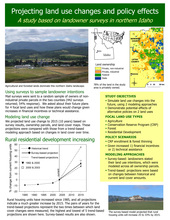Highlight
Projecting Land Use Changes and Policy Effects
Achievement/Results
With NSF-IGERT funding, graduate students at the University of Idaho have made important contributions to understanding potential land use changes and effect of policy on such changes in northern Idaho. Mail surveys were sent to a random sample of owners of nonindustrial private parcels in two counties. The survey asked about owners future plans for four focal land uses and how these plans would change given increases in financial incentives or technical assistance. The interdisciplinary team of students projected land use change to 2015 (10 years) based on survey results, ownership parcels, and land cover maps. These projections were compared with those from a trend-base modeling approach based on changes in land cover over time.
The team found rural housing units have increased since 1985, and all projections indicate a much greater increase by 2015. They also found that the Conservation Reserve Program (CRP) is a land use option that is in demand. However, enrollment is currently constrained by federal funding. The team projected that without the federal funding cap, the area enrolled in CRP would increase by 12% by 2015 and by up to 25% given an increased annual rent or improved technical assistance. The amount of land area used for agricultural crops was projected to decrease by 6 to 9% in the survey based model and by 5 to 22% in the trend-based models. CRP enrollment and residential development both contributed to this trend, and development on agricultural lands may be more pronounced if current CRP funding is not increased. The amount of low-density forest on private, nonindustrial lands was projected to increase by 20% by 2015 using the survey-based model. Forest thinning decisions showed little response to changes in policies (1% increase). This may reflect the current focus on and funding for reducing fire hazards around rural communities as a result of recent large and severe fires.
With IGERT support, these students have gone beyond their disciplinary projects and engaged in an interdisciplinary effort. This study used a multi-faceted approach to projecting rural land use change, incorporating both historical trends and landowner intentions, and is unique for its survey-based approach to simulating future changes.
Address Goals
Discovery:
Students and their faculty mentors have published a paper presenting their research in the refereed journal, Landscape Ecology, thereby contributing to the improvement of methods for achieving sustainable, ecologically sound community planning. The paper Pocewicz, A., M. Nielsen-Pincus, C.S. Goldberg, M.H. Johnson, P. Morgan, J.E. Force, L.P. Waits, & L. Vierling. Predicting land use change: comparison of models based on landowner surveys and historical land cover trends. Landscape Ecology 23:195-210, can be viewed at: http://www.webpages.uidaho.edu/~niel9897/
Learning:
Through their interdisciplinary team efforts students have learned how to tackle complex environmental problems like those our society faces using innovative approaches and collaborative science. They have also learned the importance of transmitting their findings to a diverse audience including local planners so that results can be put to practical use.






